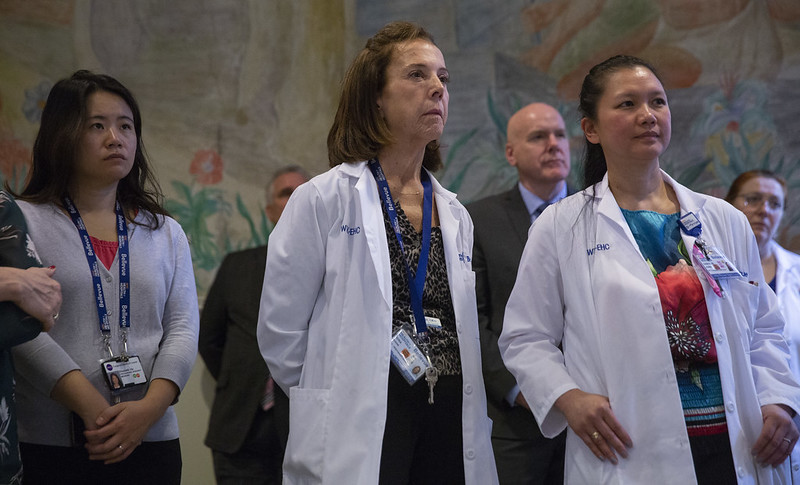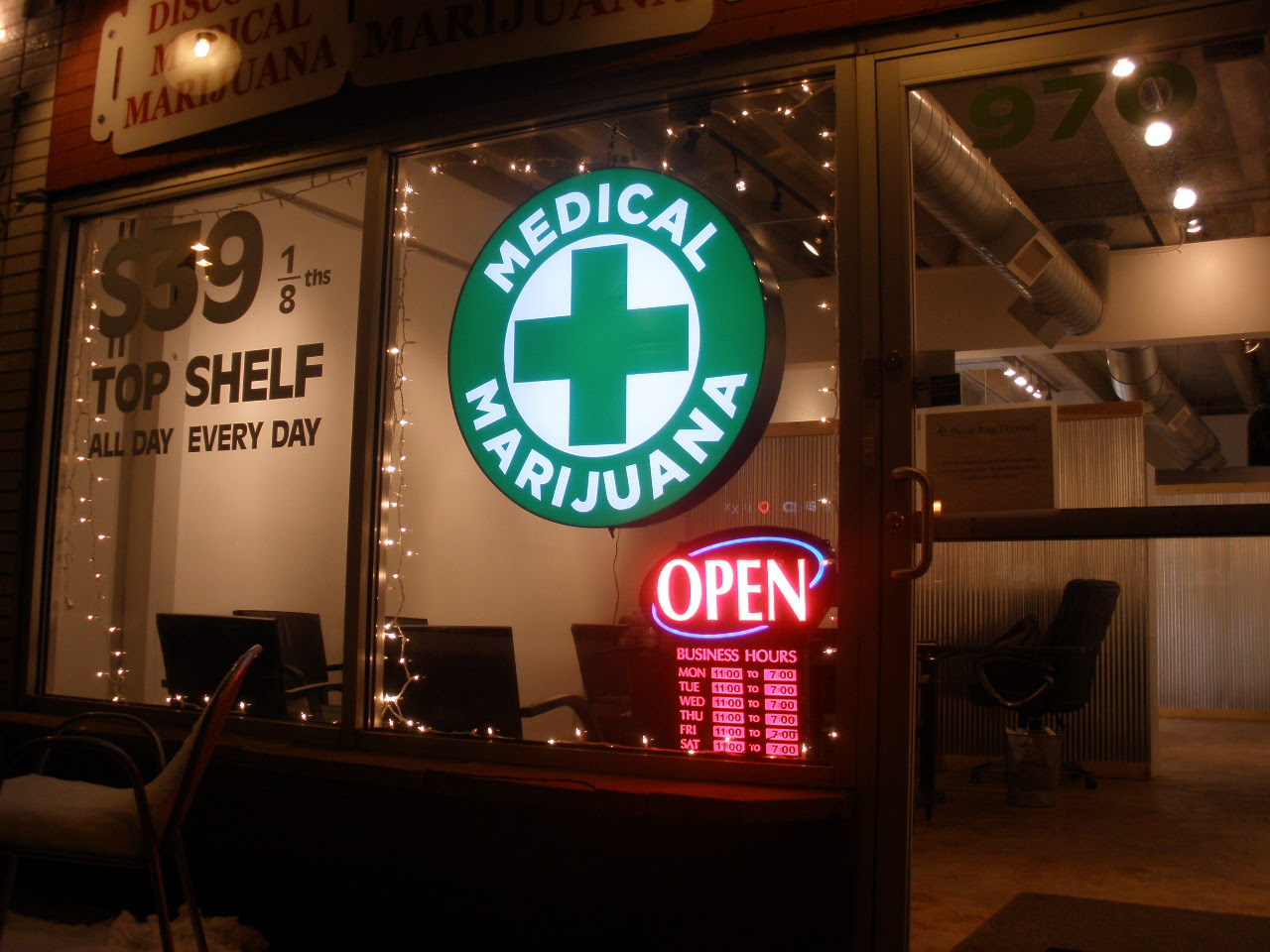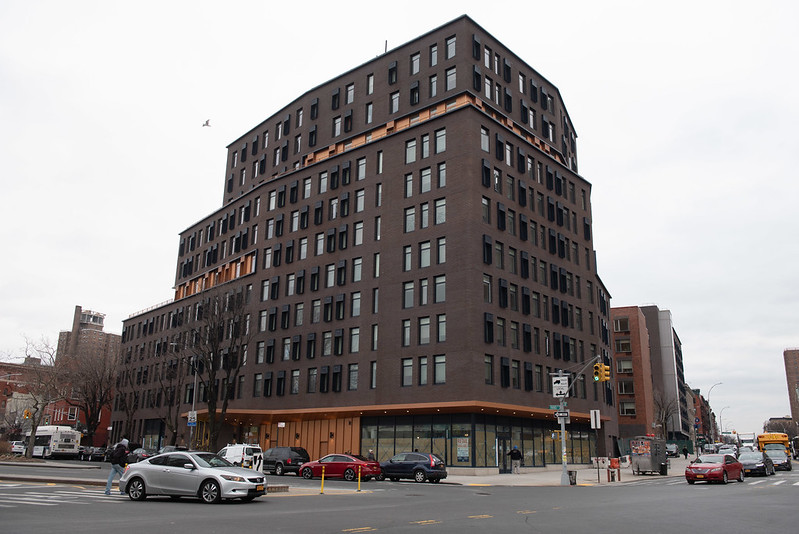Our Patients Need Medically-Appropriate Shelter, During Coronavirus Outbreak and Always

(photo: John McCarten/City Council)
What happens when a historic pandemic collides with an unprecedented housing crisis? The inextricable link between housing and health is now more apparent than ever as doctors both care for critically ill patients with the novel coronavirus, COVID-19, and simultaneously scramble to make plans for the most vulnerable in our society who simply have no place to isolate.
Only a few weeks into this crisis, we have seen numerous patients recuperating from COVID-19 who linger for days in the hospital because of their need for medically-appropriate shelter. This highlights the immediate need to establish “medical respite” opportunities. Medical respite facilities are settings that “provide a safe and humane alternative when discharge to home is not possible for people without home,” in the words of the National Healthcare for the Homeless Council. These should be available for any New Yorker in need.
In hospital and emergency medicine, providers are familiar with the idea of a ‘social admission,’ meaning that a patient may enter or remain in the hospital because he or she has no place to safely care for him- or her-self. Reasons range from needing intravenous antibiotics or oxygen supplementation, to simply “aging out” of the ability to care for oneself. Such social admissions often stay in the hospital for weeks or even months longer than would a medically-similar patient with more secure housing and social support.
Today, facilities around the country are keeping homeless patients with the novel coronavirus in hospital beds, sometimes for days, because they lack a secure non-hospital setting in which to isolate. This week in New York has clearly demonstrated that a hospital bed is a dangerously scarce, life-saving resource for critically ill people coming into the hospital in the midst of a worldwide pandemic.
Based on guidelines from the Centers for Disease Control, if a person develops fever and symptoms of a cold and is concerned about having the novel coronavirus, hospitals are generally recommending: Stay home, keep a safe distance from others, regularly wash your hands thoroughly with soap and water (or hand sanitizer), avoid public transportation, and call your doctor before reporting to one of the already-overcrowded emergency rooms, where people are equally at risk of spreading or contracting the virus. Clearly this is incredibly challenging for any person in the shelter system, living on the street, or living in an overcrowded space. For those who are homeless but avoiding the shelter system, preferring to remain on the street, protecting themselves from close contact with others, even washing their hands, may be next to impossible.
In just the first few weeks of this crisis, in a small swath of the city, COVID-19 has crudely unearthed every failing of our society when discharging patients back to the community: living 6-8 people in a studio, couch surfing after recent layoffs, and needing to avoid domestic violence. Housing is clearly complex, and the numbers reflected in the official shelter census just scratch the surface of those in our city who may have a need for respite locations.
Clearly, our society is only as resilient as the structures in place to care for the most vulnerable during a time of pandemic. We need rapid, effective access to isolation facilities for homeless and unstably-housed people who are sick but not requiring inpatient care, whether or not they have previously stayed in the shelter system.
The system must be streamlined, with the referral process clearly communicated to hospitals to facilitate expedited transfer from either hospital discharge or outpatient clinics to isolation settings. We need immediate access to individual rooms for people becoming homeless in the wake of the pandemic, having been pushed out of unstable housing or discharged from various institutions. People need the ability to come off the streets with access to individual rooms where they can safely isolate for their safety and that of others.
Every hour and every open hospital bed will count in our management of this crisis to support our inundated healthcare system as we provide life-saving care to the most vulnerable in our city, and all New Yorkers.
***
By Amanda Ramsdell, MD; William Levine, MD; Aarti Patel, PA-C; Nell Eisenberg, MD; Laura Kolbe, MD; Yinan Lan, MD; Todd Cutler, MD; David Scales, MD, MPhil, PhD; and Lucy Willis, MD. On Twitter @ARamsdell3, @aarthiparthi, @nellbell_e, @laurakolbemd, @todd_cutler, @DavidAScales, @LucyWillisMD
***
Have an op-ed idea or submission for Gotham Gazette? Email This email address is being protected from spambots. You need JavaScript enabled to view it.
Medical Cannabis Gave Me My Life Back; The Program Should Be Expanded to Help Even More People

Medical Marijuana has major benefits, the author writes (photo: Wikimedia Commons)
As a teenager growing up on Long Island, I struggled with both anxiety and depression daily. After being attacked and hurt in a workplace injury during college I began experiencing symptoms of Post-Traumatic Stress Disorder daily, and night terrors every time I attempted to sleep. My anxiety worsened considerably and became a constant companion; I was deeply depressed. Getting up was difficult, attending school felt impossible, and going to my part-time jobs was out of the question.
I wanted my life back.
My doctor prescribed multiple medications to address my many symptoms. My dosages steadily increased as a single capsule failed to bring sustained relief. Instead of getting better, my situation deteriorated. I was drowsy most of the time, basically a walking zombie.
Desperate to regain a sense of normalcy, I started to research nontraditional options. In 2014, Governor Andrew Cuomo signed a bill into law legalizing cannabis for medical use in New York, and my doctor suggested I consider this route.
Under my doctor’s recommendations, I began to experiment with different Tetrahydrocannabinol (THC) and Cannabidiol (CBD) ratios to figure out what works best for me. Eventually, we landed on a combination of an oromucosal spray with a high CBD ratio in the mornings to keep me calm and capsules or vaporization in the evening to help me sleep.
The results have been overwhelmingly positive. I was able to slowly wean myself off my traditional medications with my doctor’s oversight and get back to my life – whether it be going out with my dogs or hanging out with friends – just really enjoying everything I loved but hadn’t been able to do.
Getting up became easy and going to school became fulfilling and interesting – so much so that I decided to pursue an M.S. in Medical Cannabis Science and Therapeutics at University of Maryland’s School of Pharmacy to truly understand the benefits of cannabis.
In short, medical cannabis works, not just for me, but for the 114,000 other certified patients who benefit from New York’s program.
But we can do more.
Medical cannabis medication is not covered by insurance. To afford my treatment, I’ve had to cut costs and stick to a strict budget. Thankfully, my local dispensary offers discounts and other programs to make sure people like me can get the products we need to live full, productive, and pain-free lives.
Also, I’m lucky that my PTSD and attendant symptoms have been included on the list of qualifying conditions to be able to access medical cannabis. I know many more people could get relief like I have if the state broadened the list further, and I’m thankful additional conditions have been slowly added since the program began.
The current patient-to-dispensary ratio of 500,000 to 1 in New York is also an obstacle preventing people like me from accessing medical cannabis. It doesn’t make sense to me that there’s a drug store within easy access in almost every community in the state, but some medical cannabis users must travel hours to obtain the treatment on which they rely.
Greater access, lower costs of medication, and fewer barriers in terms of qualifying conditions should be the standard in New York. As the governor and state lawmakers consider expanding legalization of cannabis to include adult recreational use, they need to recognize the importance of protecting and growing the medical program that is already helping so many people like me – and could, with the right support, help many more.
***
Alison Dixon is a Long Island resident and Curaleaf patient.
***
Have an op-ed idea or submission for Gotham Gazette? Email This email address is being protected from spambots. You need JavaScript enabled to view it.
The Coronavirus Crisis Demands a Federal Emergency Housing Response

Keeping people in their homes is of the essence, the author writes (photo Michael Appleton/Mayor's Office
The federal response to the economic crisis just over a decade ago swiftly bailed out banks and other financial institutions, but left far too many struggling families in the lurch. It was too little, too late. This was devastatingly true for black families, whose home-ownership rates dropped from 50% to 42%, representing an enormous loss of generational wealth.
We must respond differently this time to ensure that homeowners hold onto their homes and apartment building owners and renters maintain safe and stable housing through the COVID-19 public health crisis that has also spurred an economic one. And because it is a health crisis, we should first prioritize vulnerable populations like those without a home and low-income renters at risk of homelessness.
While we are still processing the gravity of COVID-19’s destructive capacity and the consequences for our families, communities, and economy, as has occurred in past natural disasters, we know the effects on homeless people, low-income renters, and homeowners will be catastrophic unless we act quickly. Federal housing assistance is desperately needed both to slow the spread of the coronavirus and in response to what is looking like a significant economic downturn as businesses and entire industries may be closed for months while capital markets are in turmoil and job losses skyrocket.
Emergency housing assistance is a critical component of a comprehensive response of public policy measures to stop the spread. New York already has an alarming number of confirmed cases of the new coronavirus in homeless shelters. Statewide, there are more than 92,000 homeless people. In addition, 100,000 children were living doubled up last year in overcrowded homes. Without the ability for social distancing or isolation, homeless people are at great risk while living on the street, in congregate shelters, or doubled-up in close quarters.
If the virus spreads through the 841 beds in the Bellevue men’s intake facility, for example, those men could nearly fill the 1,000-bed naval hospital ship scheduled to sail to New York City to bolster hospital capacity next month.
Federal resources must be appropriated for a swift response or COVID-19 is certain to rip through congregate shelters, street homeless communities, and reverse other containment efforts. Congress must appropriate at least $15 billion in McKinney-Vento Emergency Solutions Grants to move homeless people off the streets and out of crowded shelters.
Rental assistance and rapid re-housing programs can be used, as they have in the aftermath of other national crises, to house vulnerable populations. This time, these housing programs can also save lives.
The White House and Senate Republicans have included zero emergency housing assistance in the stimulus package currently being negotiated. This is a strategy to fill hospital beds at a rapid pace and further overwhelm our health care system.
And while they are proposing direct assistance — up to $1,200 to individuals — it will be insufficient, particularly in high-cost markets. In New York City, where 50% of all households already pay more than 30% of their income towards rent, the median rent was $1,450 in 2017.
According to the New York State Department of Labor data, in January there were roughly 1.3 million people in the state working in hospitality jobs in the arts, hotels, or restaurants and bars, or in retail jobs like clothing, electronics, and sports. Most of these people are now out of a job. Their income has been reduced to zero.
We are grateful that these workers will have the protection of the state’s foreclosure and eviction moratoriums. However even with this, people aren’t going to be able to afford the back payments in six or 12 months. A moratorium alone is only kicking the can down the road. We need assistance now that is appropriately sized to cover household costs.
Fannie Mae and Freddie Mac offered loan forbearance for building owners who offer protections to their renters. This approach makes sense because it shows that we are all connected and in it together, even when we are trying to keep six feet apart. But much more needs to be done.
The New York City Housing Authority (NYCHA), steward of New York City’s most affordable housing, also estimates that it will need $300 million in additional operating funds to cover rent losses, and additional time and contractors to keep up with the higher standards of cleaning now required to protect its 400,000-plus residents. All properties assisted by the federal Department of Housing and Urban Development (HUD) and the Section 8 program will face the same challenge of declining income and insufficient funding. Congress must include these critical HUD programs in the stimulus to ensure that these programs are fully funded and families are not kicked off programs due to lack of funds.
We urge Congress to do the right thing this time and ensure there is emergency housing assistance in the economic stimulus and coronavirus recovery bill that protects renters and homeowners across the nation. This is how we can do better than our response in 2008, help families hang onto their homes and vulnerable renters stay in their apartments.
***
Rachel Fee is Executive Director of New York Housing Conference, a statewide affordable housing policy organization. On Twitter @RachelFeeNYHC & @theNYHC.
***
Have an op-ed idea or submission for Gotham Gazette? Email This email address is being protected from spambots. You need JavaScript enabled to view it.




